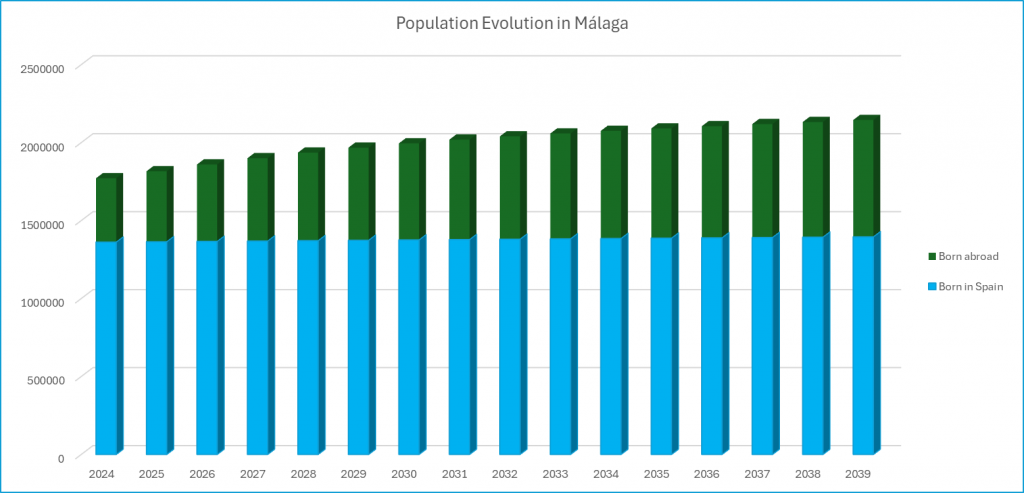According to recent data from Spain’s national statistics institute, INE, the population of Malaga province is set to exceed two million by 2031. This milestone will see Malaga surpass Seville, the capital of the Andalucía region. Projections show Malaga with 2.018 million residents compared to Seville’s 2.014 million.
Currently home to 1.77 million people, Malaga’s population is expected to grow by nearly 14% in less than a decade. In contrast, Seville’s population will see a modest increase of 2.3%, rising from the current 1.97 million.
Malaga’s growth rate will outpace not only Seville but also the broader Andalucía region and Spain as a whole. The INE forecasts a 5.8% population increase in Andalucía, from 8.628 million in 2024 to 9.127 million in 2031. Nationally, Spain’s population is expected to rise by 7.4%, from 48.6 million to 52.2 million in the same period.
Driving Factors Behind Malaga’s Growth
The rise in Malaga’s population will primarily be driven by an influx of foreign-born residents. The Spanish-born population in the province will see a modest increase of 1.2%, growing from 1.362 million to 1.378 million. In contrast, the number of Spanish-born residents is expected to decline by almost 2% nationwide, and by 1.3% in Seville.
Foreign-born residents will significantly contribute to Malaga’s population growth, with their numbers projected to increase by 56%, from around 410,000 currently to nearly 640,500 by 2031.
Seville will see a 49% rise in its foreign-born population, from 140,637 in 2024 to approximately 210,000 by 2031. In Andalucía, the foreign-born population is expected to grow by 54%, reaching 1.645 million by 2031, while the national increase will be 50%, totalling 13.180 million.
Malaga: Andalucía’s Most Populated Province by 2039
Looking further ahead, the INE’s projections extend to 2039, by which time Malaga will solidify its status as Andalucía’s most populated province. The population is expected to reach 2.144 million, compared to Seville’s 2.021 million. This growth represents an over 20% increase from current levels, more than doubling the national population growth rate of 10.5%.

Malaga will be one of the top provinces in Spain in terms of population growth, adding over 383,000 residents in the next 15 years. It will rank fifth in absolute population increase, behind Madrid, Barcelona, Valencia, and Alicante, and seventh in relative growth at 22%. Almería is projected to experience the highest relative increase in Spain, growing by 28%.
With an increased population, the demand for property to both rent and buy will also increase. This provides real estate investors with additional reassurance their projects will bear fruit.
Contact SPI for details on properties available, including off-market for residential use and investment.
Population Dynamics Over the Next Three Decades
Between now and 2039, Malaga’s Spanish-born population is projected to rise by 2.5%, in stark contrast to a national decline of 3.64%, a 2.64% decrease in Seville, and a 2% drop in Andalucía.
Meanwhile, the foreign-born population in Malaga is expected to surge by 83%, reaching nearly 750,000 by 2039. Andalucía and Spain will also see substantial increases of 80% and 74%, respectively, in their foreign-born populations, while Seville will experience a 72% rise.
Migration and Birth Rates
INE statistics indicate Malaga’s population growth will not be driven by a higher birth rate. In 2024, the province is expected to have 6.66 births per 1,000 inhabitants, similar to the national average and lower than Seville’s 7.38 births per 1,000 inhabitants. By 2031, when Malaga’s population is set to surpass Seville’s, the birth rate will be 6.75 per 1,000 inhabitants, still below the national average and Seville’s 7.72. By 2038, the birth rate in Malaga is projected to be 7.03 per 1,000 inhabitants, compared to Spain’s 7.52 and Seville’s 8.57.

Instead, Malaga’s population growth will rely heavily on immigration. In 2024, the province is projected to attract 37 migrants per 1,000 inhabitants, decreasing to 22 per 1,000 by 2031, and further to 16.7 per 1,000 by 2038.
Malaga is working on a number of projects to enhance the city and province for new residents and businesses.
